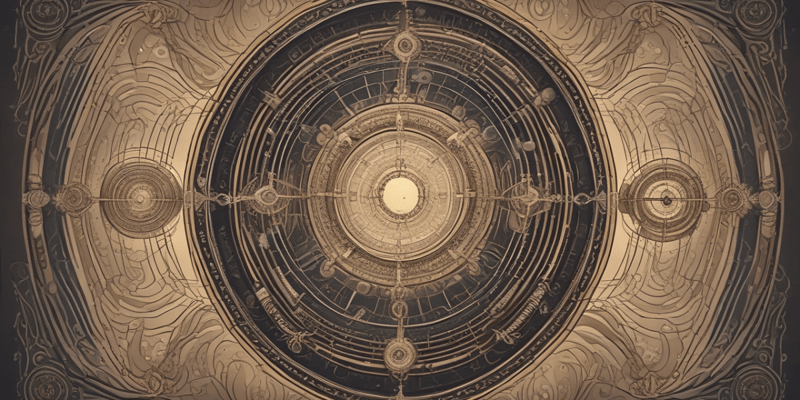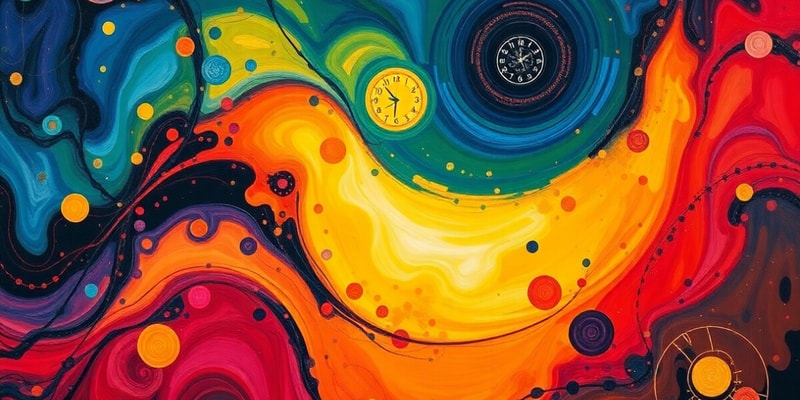Podcast
Questions and Answers
What is the primary purpose of circadian rhythms in living organisms?
What is the primary purpose of circadian rhythms in living organisms?
How does the suprachiasmatic nucleus (SCN) affect the circadian rhythm?
How does the suprachiasmatic nucleus (SCN) affect the circadian rhythm?
What is the estimated duration of the human circadian rhythm in the absence of external cues?
What is the estimated duration of the human circadian rhythm in the absence of external cues?
Which of the following describes a potential consequence of jet lag?
Which of the following describes a potential consequence of jet lag?
Signup and view all the answers
What role do zeitgebers play in relation to circadian rhythms?
What role do zeitgebers play in relation to circadian rhythms?
Signup and view all the answers
During which time does melatonin secretion typically begin?
During which time does melatonin secretion typically begin?
Signup and view all the answers
What was the significant finding from the 1938 study conducted by Kleitman and Richardson?
What was the significant finding from the 1938 study conducted by Kleitman and Richardson?
Signup and view all the answers
What is one hypothesized evolutionary reason for the development of REM sleep in birds and mammals?
What is one hypothesized evolutionary reason for the development of REM sleep in birds and mammals?
Signup and view all the answers
Which hormone is primarily managed by the SCN to regulate sleep-wake cycles?
Which hormone is primarily managed by the SCN to regulate sleep-wake cycles?
Signup and view all the answers
Which phenomenon is characterized by a mismatch between the internal circadian clock and external time after crossing time zones?
Which phenomenon is characterized by a mismatch between the internal circadian clock and external time after crossing time zones?
Signup and view all the answers
Study Notes
Circadian Rhythms
- Circadian rhythms are biological processes with an approximately 24-hour cycle length that are generated internally (endogenous).
- Zeitgebers are external cues that synchronize the body's internal clock, such as the suprachiasmatic nucleus (SCN).
- Circadian rhythms regulate sleep-wake cycles, eating, drinking, body temperature, and hormone release.
Why We Have Circadian Rhythms
- Circadian rhythms allow living species to sync their behavior and internal biology with the Earth's 24-hour light/dark rotation.
History of Circadian Rhythms
- Jean-Jacques d'Ortous de Mairan (1729) demonstrated circadian rhythms in plants by studying leaf movements over a 24-hour period, even in the absence of light.
- Kleitman and Richardson (1938) spent six weeks in Mammoth Cave, Kentucky, demonstrating the endogenous nature of human circadian rhythms.
- They found that the human circadian clock generates a rhythm slightly longer than 24 hours in the absence of external cues.
- The average circadian rhythm for most humans is estimated to be approximately 24 hours and 10 minutes.
Body Temperature and Circadian Rhythm
- Body temperature reaches its lowest point for the day about two hours after sleep onset and peaks approximately six hours before sleep onset.
Master Clock and Regulation
- The suprachiasmatic nucleus (SCN), located in the hypothalamus, is the master clock that regulates circadian rhythms.
- The SCN controls brain and body activity levels to regulate wake and sleep patterns.
- The SCN uses melatonin, a chemical messenger released from the pineal gland, to regulate circadian rhythms.
Melatonin
- Melatonin is released from the pineal gland, beginning about two hours before bedtime.
- Light suppresses melatonin secretion, while darkness triggers its release.
- Melatonin remains high throughout the night and is suppressed during the day.
Zeitgebers and Circadian Rhythm Resetting
- Zeitgebers are any stimuli that reset our daily circadian rhythm to precisely 24 hours.
- Light is the most important zeitgeber due to its reliable 24-hour cycle.
Circadian Rhythm Disruptions
- Jet Lag is caused by a mismatch between the internal circadian clock and external time due to crossing time zones.
- Melatonin pills can help phase-advance the internal clock, making it easier to sleep in a new time zone.
Two-Process Model of Sleep-Wake Regulation
- The circadian factor process (Process C) is one of the two processes governing sleep-wake rhythms.
- As the circadian rhythm increases, our drive to be awake increases and vice versa.
Studying That Suits You
Use AI to generate personalized quizzes and flashcards to suit your learning preferences.
Description
Explore the fascinating world of circadian rhythms and their significance in biological processes. Understand how internal clocks and external cues, like light and darkness, influence behaviors such as sleep, eating, and hormone release. Learn about the historical studies that shaped our knowledge of these rhythms.




